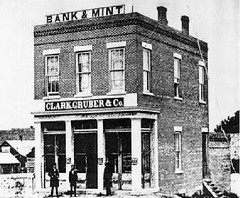
PREV ARTICLE
NEXT ARTICLE
FULL ISSUE
PREV FULL ISSUE
MORE ON THE VARIOUS U.S. MINT BUILDINGSPete Smith writes: It was the second San Francisco Mint that survived an earthquake in 1906, not the third as you show in The E-Sylum. Based on your response about the columns of the (second) third Philadelphia Mint, I suspect that some people find this area confusing.
That caption was my fault, not Mark's. I've been to that building and knew which one it was, but somehow I called it the third instead of the second.
And it was my faulty caption that dubbed the second Philadelphia Mint as the third. Sorry! I guess my wife is right - I AM an idiot. I'll take some remedial counting lessons from my six-year-old, Hannah. She'll set me straight.
-Editor
Bob Neale writes: Regarding Mark Borckart's list of mint buildings, allow me to comment regarding the following from Mark and to update my total to 18 facilities. Mark wrote: 15. The Denver Mint of Clark, Gruber was intended to be operated as a United States Mint, although the government produced no actual coins at that facility. 16. The U.S. Assay Office in San Francisco, operated by Augustus Humbert absolutely qualifies 17. The “Fugio” Mint where the 1787 Fugio cents were produced. Also, we could add "Harper's cellar" to the list for the 1792 half dismes... If the Charlotte Mint burned down before coinage began (and I have never heard of that before) was rebuilt, was it also reauthorized? If not, then it doesn't count as two, only as one. The only southern mint that burned down, to the best of my knowledge, was Dahlonega, but that was long after coinage ended.
[2] If Humbert's 1851 SFO assay office (Moffat & Co) was titled as a provisional mint, as noted in the Red Book, I guess the $50 pieces should be considered official coinage. Thanks, Mark. [3] I don't count the 1787 Fugios because there was as yet no U.S. Government and Congress under the Constitution. But I should have framed my question more carefully. [4] Harper's Cellar wasn't a facility authorized by Congress, was it? It was just convenient.

[5] The Charlotte Mint was authorized 3 March 1835, minted coins 1838-1844, burned down in 1844, rebuilding was authorized by Congress 3 March 1845, and minting resumed October 1846. So I took it as two facilities.
Many thanks to both Mark and Bob for their contributions on this interesting topic. Below is a quote from p147 of Statzenberger's 1976 book, "The Establishment of the Charlotte Branch Mint".
-Editor
On the night of July 27, 1844, it was nearly destroyed by fire, which occurred in the coining room, and nearly consumed the entire building. The machinery was seriously injured but the records being stored in the vault, were not injured. Mr. Caldwell, the superintendent, reported that evidently the fire was the work of a thief, as his living apartments had been entered and articles stolen. The present building was authorized by an act of March 3, 1845, and was completed at a cost of $31,572.97, and occupied in 1846, and used for coinage purposes until May 20, 1861, when North Carolina entered the Confederacy and operations were suspended. The building was used during the Civil War as a Confederate hospital.
On a related topic, last week I noted that I'd received an email from a web site visitor named George Young saying "The William Strickland Columns referenced in your article are at George Young Company in Swedesboro, NJ."
Well, on Friday afternoon I gave George a call and had a very pleasant conversation. The columns we've been looking for have been in storage since the mid-1990s, first in the Philadelphia area after they'd been removed from the Einstein Hospital grounds, then in New Jersey following the company's move. His company is the go-to contractor for the movement and installation of large artworks in the Philadelphia region. Most columns of this sort are built in sections and held together with pins, but these impressive columns are each a single piece of stone. They stood at the entrance of the second Philadelphia Mint from 1833 to about 1904. The Einstein Hospital is exploring possible new uses for the columns, and George will keep us informed of new developments. Meanwhile, these interesting architectural artifacts will remain in safe storage (not that anyone is going to make off with them in a pickup truck). -Editor
To read the earlier E-Sylum article, see:
QUIZ ANSWER: HOW MANY DIFFERENT U.S. MINT BUILDINGS?
(www.coinbooks.org/esylum_v13n24a12.html)
The Numismatic Bibliomania Society is a non-profit organization promoting numismatic literature. See our web site at coinbooks.org. To submit items for publication in The E-Sylum, write to the Editor at this address: whomren@gmail.com To subscribe go to: https://my.binhost.com/lists/listinfo/esylum All Rights Reserved. NBS Home Page Contact the NBS webmaster 
|
